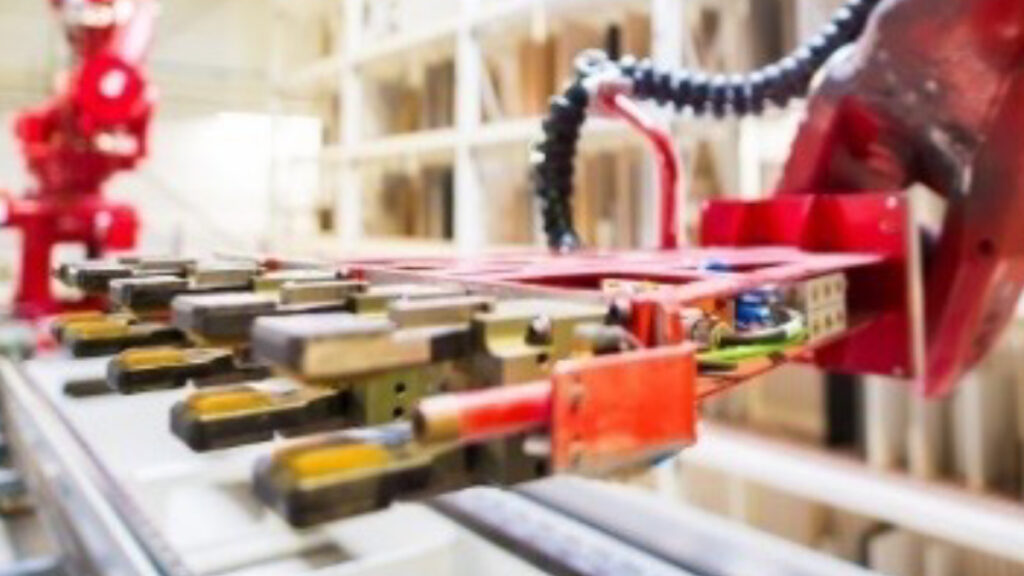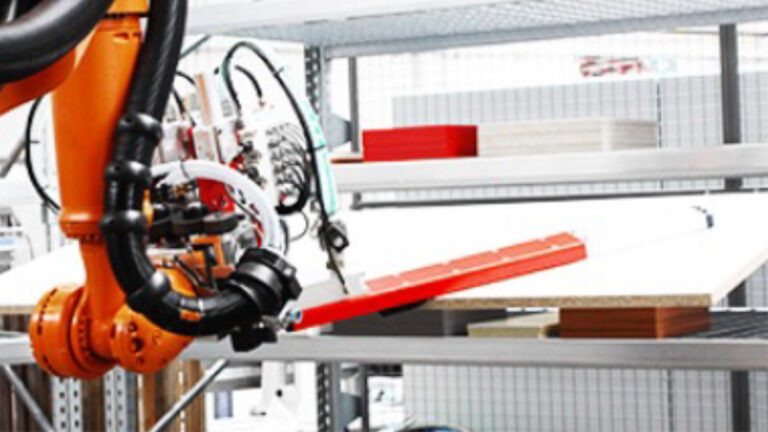A very effective alternative to manual sorting and picking are system-supported sorting solutions, which are offered by various suppliers in different expansion and performance classes.
Common features and advantages of systemic solutions for component sorting
- Sorting a chaotically arriving stream of parts creates a controlled material flow for the subsequent processes
- Material flow can be further optimized thanks to freely definable storage and retrieval strategies
- Workpieces can be sorted out according to various criteria such as tour, carcase decor, parts group, material group, target workstation in the subsequent process, preliminary parts, completeness of the carcase parts, etc.
- Optimum because systemic handling for parts to be inserted (visible sides, painted sides, contour parts, reject parts, etc.) or rejected parts (no-read, QA inspection parts, Baumer detection, pre-run parts, etc.)
- Maximum transparency thanks to position-accurate parts tracking and fully visualized parts management along the entire storage and sorting process
- Multiple function consisting of parts buffering + decoupling the edging system from the downstream process + component sorting + completeness of components on removal for downstream process
- Increase in production output and productivity
- Plannable production processes thanks to high process reliability
- Improved material utilization through intermediate storage and timely sorting of optional parts
- Modular scalability of the sorting cells with volume growth and increasing requirements is conceivable
Customer-specific criteria for different system solutions and possible concept approaches
- Basic production philosophy for component production depending on the quantity structure / production volume per day –> strictly order-related parts production from cutting plan optimization or series production at the component reference level and picking from high-bay warehouse
- Cell length and width, hall height, other structural conditions (e.g. hall supports)
- Design of the edging machine as a single machine, two single-sided KAMs in a row or 4 single-sided edging machines linked together – Decisive for cycle output and peaks
- If the sorting cell is to be installed in direct interlinking with KAM or decoupled
- Cycle output in parts/minute on upstream edging machine on average, but especially at maximum peak (particularly important when linking two single-sided KAMs after second part circulation)
- Output in components per hour, shift or day
- Depending on this: Manual loading/unloading/stacking or automated loading/unloading/stacking
- Decoupling of infeed side from outfeed side required due to cycle and unit output and other frame corner points
- Component dimensions and thicknesses
- Storage capacity and therefore the size of the sorting wall depends on the customer’s requirements in terms of parts volume, process organization and actual process reliability
- Unique carcass parts in direct individual part access or is storage/sorting by component reference with subsequent component reallocation including relabeling conceivable?
- Capital expenditure budget
Concept approaches for parts sorting for furniture companies with strictly order-related component production from cutting plan optimization onwards
As already briefly discussed above, companies in the furniture industry pursue fundamentally different manufacturing philosophies in component production against the backdrop of higher production volumes, for example. Consequently, these companies have different requirements/demands on sorting and therefore pursue different concepts and solutions. Describing these in detail would go beyond the scope of this article. The focus should therefore be on the solutions and conceptual approaches that can be considered for strictly order-related part production from cutting plan optimization – without any claim to conclusive completeness and all variations.
- Rack with pick-to-light – a very simple, manual and yet system-supported component buffer and picking in combination with a pick-by-light system: a storage compartment is assigned to the individual workpieces via scanning; the operator confirms the storage of the component by pressing a button in this very storage compartment and thus establishes a clear reference in terms of data technology. This ensures that the contents can be tracked and that they are only released for retrieval when all the components in a production order are complete.

Conversely, a pick-to-light display provides the employee with visual support when retrieving items so that time-consuming searching combined with a certain frequency of errors can be reduced to a minimum. The target group for this system is smaller companies in the interior fitting, store fitting and hotel equipment sectors with approx. 250 sorted parts per day and a sorting and picking performance that is not really decisive.
- Vertical lift system with trays – for example, the KARDEX Shuttle XP: This solution can also grow in line with the customer’s requirements in terms of the number of devices. In an initial expansion stage, the parts are manually placed on a tray and the data is married to the tray by scanning the component/component label. The cycle times for such devices are approx. 45 seconds per tray double cycle from the middle storage position. Depending on the required cycle performance, it makes sense to provide at least two devices. However, in order to avoid waiting times in the storage and picking process even when using several appliances, it is important not to store the same component references in just one appliance.

In terms of storage capacity, it is important to make maximum use of the available internal shelf height of 75 mm (depending on shelf width, depth and load category) without parts protruding over the edge of the shelf. Multiple storage of the same component references on top of each other (same length+width+thickness+decor+groove pattern) can significantly increase storage capacity. During order picking, however, it may be necessary to reallocate parts and relabel the workpieces. During storage and retrieval, the picker can be guided and supported by the laser pointer option. This additional function helps to prevent picking errors. In a further expansion stage, a combination with robots on a traversing axis for storage and retrieval/picking would be conceivable. However, there are restrictions to be considered, for example due to part geometries (small or narrow parts stored on the rear tray surface) and stacking heights. The target group for this system are companies with an output requirement of approx. 50 – 200 storage and retrieval parts per hour.
- Another sorting solution is sorting warehouses based on storage and retrieval machines (SRMs) – for example the SORTEQ R-200 picking center from HOMAG. The sorting aisles can be individually adapted in terms of rack length and height, the number of aisles and the number of SRMs to the requirements of the project and the structural conditions on site. Depending on the component width, the workpieces can be stored horizontally with a minimum distance twice behind each other and, depending on the workpiece length, with a distance several times next to each other, so that the storage capacity can be maximized accordingly.

However, not all components are then directly accessible as individual parts during picking, which means that it may be necessary to restack the front workpiece at the expense of picking performance. The storage and retrieval of components can take place for single or double parts or also in the form of part tracks or entire component layers. All components are recorded with their storage location in the buffer by the control system or warehouse management software.
- An intelligent modification of this form of storage, retrieval and order picking is the use of individual, segmented lifting devices in a row, which makes good investment sense. Parts infeed and outfeed are independent of each other thanks to separate transport sections. Another design feature is the synchronized lifting elements for handling the sides of appliances or tall cabinets, for example. This conceptual approach makes it possible, for example, to keep the components of a commission closer together in the parts storage system for storage and thus for retrieval. This enables much more targeted access to parts (individual parts or multiple parts) and more effective picking overall.

In this direction, IMA offers a solution in which not only one rack row can be served from one side, but a rack aisle with its opposing racks and rack levels. With regard to the decisive factors of part volume / cycle performance / storage capacity, the two concept solutions mentioned above can be individually configured according to performance requirements and scaled as required in the event of further growth.
- Of course, robot technology has also long since found its way into the furniture industry. Various suppliers offer robot-assisted sorting cells, some of which differ significantly from one another. The SORTBOT R-300 robot sorting cell from HOMAG is a good example of this. In this conceptual approach, up to 16 standard racks are arranged in a circle around a centrally positioned robot – plus optional narrow part spaces. With different rack types and up to three storage compartments on top of each other, the quantity distribution in the individual length categories of the sorted parts is to be taken into account.

The infeed section is the same transport section as the outfeed section and at the same height. The workpieces are fixed vertically between brushes so that targeted access to individual parts is possible at any time. The same robot with a corresponding gripper solution is used to store and retrieve individual parts – both at the expense of cell performance. In order not to lock the edging line for this reason, it may be necessary to set up several cells in series and to integrate a chain stroke accumulator to decouple the output of the edging line and the storage capacity. Depending on the flow of parts in the infeed, there is a priority control for storage and/or retrieval. Of course, every storage or retrieval process in this solution is also managed and sustainable via the higher-level storage software.
- A similar sorting cell was exhibited by the IMA Schelling Group at LIGNA 2019, among others. The differences here were that the workpieces were sucked in and handled with a very slim vacuum system. In addition, the workpieces were buffered horizontally in shelving elements that are similar to conventional pallet racks. However, this results in reference-related stacks of parts (same length+width+thickness+decor+groove pattern).

Although this multiple storage of identical component references on top of each other can significantly increase storage capacity, the workpieces have to be reassigned and relabeled during component picking – at least if the label contains customer-related information. Parts handling is generally an individual parts handling process, so that even with this concept approach, several sorting cells and a chain lift storage system are required for decoupling for capacity reasons.
- Fives cinetic, a French system supplier and specialist in component sorting, offers an innovative and proven solution for component sorting. Its solutions are already widely used, primarily in the French kitchen industry, thanks to a large number of projects that have already been implemented. The fives system and technology have also proven themselves in this country, with several sorting systems having been installed or currently being installed at German kitchen manufacturers. How does the fives sorting concept differ from the solutions described above?
The infeed and storage side is completely decoupled from the outfeed and outfeed side, resulting in clear, non-overlapping material flows. The two areas do not influence each other, which means that there are no process-related waiting times or mutual process disruptions. This makes the overall system much simpler, while still allowing maximum customization to meet customer requirements. In addition, simple and comprehensible rules in the software, as well as the use of standard components and standard robots (ABB, KUKA, Fanuc, Yaskawa), contribute to high availability and ultimately high plant utilization (95 percent).

Flip flaps are used on the infeed side to distribute the flow of parts; these guide the workpieces arriving from an edge sorting line to different transport levels for the various storage robots, thus ensuring an even load. On the infeed side, the components are aligned with a reference line on the infeed transport line and picked up by pneumatic grippers. Up to three components with a length of up to 800 mm and up to two components with a length of up to 1200 mm are handled in one cycle, with HS sides then handled individually. This results in a significant increase in performance with an average of 5 cycles per robot. Depending on the peak performance in particular, a chain lift accumulator may be required for decoupling from the KAM and represent an economical alternative to investing in another robot. On the storage side, all components are then stored at a reference line in the sorting wall.
Any dimensional deviations in the width/depth of the workpiece are then moved to the rear and taken into account when the parts are picked up from the sorting wall. The length and height of this sorting wall depend on the customer’s requirements in terms of buffer capacity and the actual structural conditions. The normal case is a net storage capacity of 2500 – 3000 components, but sorting storage systems with up to 4500 components have also been implemented. In contrast to the storage side, the components on the retrieval side are handled exclusively as individual parts. Consequently, more robots must be provided on the retrieval side to handle the volume of parts. The final required part sequence in the racks or destacking sequence on the pallets is also generated by the system using the above-mentioned flip flaps. Fives also offers various clever solutions for important secondary functions, such as the handling of rejected parts (no read parts, QA test parts, parts from Baumer detection, pre-run parts, process stops in the KAM throughput, etc.) and also of feed parts (viewing sides, painted sides, contour parts or other pre-run parts, failed or post-run parts, etc.).
The solutions from fives are tailored to the performance data of medium-sized and large industrial furniture companies and offer concept solutions ranging from 1,000 to 7,500 sorted parts per shift, with a storage capacity of 900 to 4,500 components, with a series of x robots with an average storage capacity of 5 to 20 parts per minute – peaking at up to 30 components. Individually scalable and designed to meet the requirements of today’s customers for tomorrow…

Solutions and conceptual approaches for component destacking after part sorting
An essential function of the sorting cells is the temporary decoupling between the process step “workpiece processing edge machine” and the subsequent processing “final assembly assembly lines.” Depending on the requirements of the further work steps and the configuration of the assembly lines, all components of a body can be removed as a kit or according to part groups (sides, bottoms, rear wall, etc.). In any case, however, the workpieces must be sorted in the final processing or assembly sequence required for the assembly lines and removed, fed and destacked in reverse order. There are also different solutions for this, which are primarily determined by the parts output per minute, the number of parts per day and the picking quality.
This generally rules out manual component picking.
With ISG’s sorting cell, the storage robot can simultaneously handle the retrieval of components and stack them on pallets in a Tetris-like manner, optimizing space and achieving extremely high packing densities. Other providers solve this problem with destacking portals. fives also offers a solution that is based on this, but is different in other ways… The destacked workpieces are used to form part tracks under the portal and are stacked on an in-house pallet that has been divided in the software into several reference lines in pallet widths in a 50 mm grid. This also results in almost maximum packing density with a maximum of one pallet for the part volume of an average tour, thus minimizing space requirements and traffic in the plant. Another solution could be to stack the body parts in racks, where the individual body parts are also held between brush strips. In this solution, the components are sorted into the rack according to type in the order in which they are assembled, from top left to bottom right, so that each individual component is directly accessible at all times – where necessary and appropriate. This concept requires that the assembly lines are also fed by a robot or a combination of robot and gantry. In addition, the number of parts per rack is lower than with an in-house pallet, the space requirement is considerable due to the size of the racks, and the investment costs are not negligible. Fives also implemented a third option: Shelves are transported directly to the assembly lines at the customer’s site and stored in MRFs leaning against each other in racks; the other body parts are stacked in multiple lanes per part layer on in-house pallets as described above. This solution offers maximum freedom and flexibility in picking and material feeding. Of course, there are other good solutions here too, and the same applies: the customer’s requirements and circumstances determine the concept solution. This process step is complete when the internal transport from the destacking sorting cell to the assembly line via driverless transport systems (AGVs) is taken into account – at least in a further expansion stage.
Conclusion: As shown, there are a number of approaches and technical concepts for system-supported component sorting. However, there is no single solution that is always right. For example, a HOMAG RBG sorter with multiple depths may be the right solution for “sorting 2 parts per minute with an average batch size of 3 parts per part reference and approx. 100 part references,“ a HOMAG RBG sorter in multiple depths may be the right solution, or for the requirement ”sorting 4 parts per minute with an average batch size of 1 part per part reference,” a fives sorter solution with one input and one output robot may be the right solution…. It is therefore always important to consider the individual requirements/needs/part range/conditions/framework conditions, weigh them up and analyze them in detail. Only in this way can the right and optimal solution for the customer be developed jointly.




